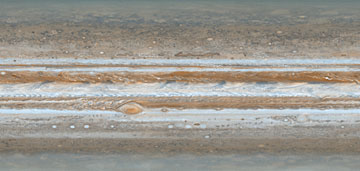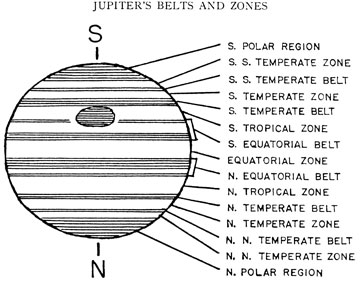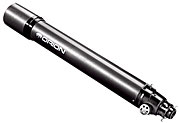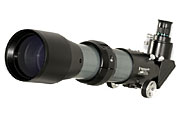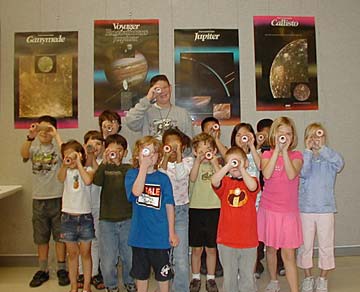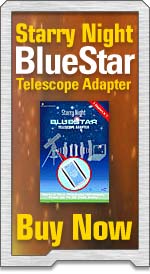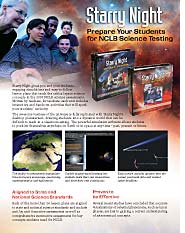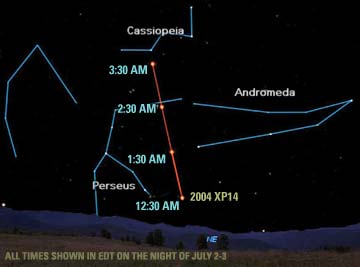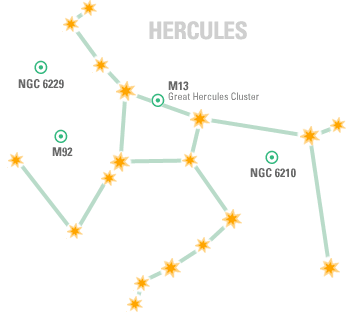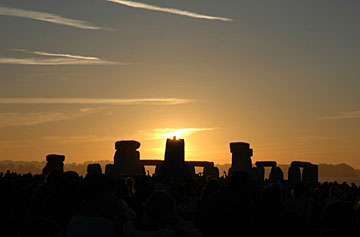 |
||||||||||||||||||||||||||||||||||||||||||||||||||||||||||||||||||||||||||
|
If you have trouble viewing this newsletter, click here. Welcome again to our monthly newsletter with features on exciting celestial events, product reviews, tips & tricks, and a monthly sky calendar. We hope you enjoy it!
Jupiter is the largest planet in our solar system. It is known as a “gas giant” because it is almost entirely made of gas and has no solid surface. All we ever see of Jupiter is the topmost layers of the clouds that make up its very thick atmosphere. Jupiter rotates very rapidly, spinning faster than once every ten hours, which forces the clouds into prominent horizontal bands: the darker ones called belts and the lighter ones called zones. Everything we see on Jupiter is activity in Jupiter's upper atmosphere, and is unconnected to anything on Jupiter's surface (such as it is). Even the largest and most striking feature in Jupiter’s atmosphere, the gigantic anticyclone known as the Great Red Spot, is strictly an atmospheric phenomenon, unconnected to anything below it. This is shown by the fact that the Red Spot has drifted back and forth in longitude over the many years it has been observed. The Great Red Spot was discovered by Giovanni Dominico Cassini in 1665, and has been observed by astronomers ever since: 341 years is a remarkably long lifetime for a weather system! Over the centuries, aside from drifting back and forth in longitude, it has varied greatly in size, color, and visibility. In some years it has been brick red and extremely obvious, but most of the time it varies between pale yellow and salmon color. In recent years, it has become very pale, but this year its visibility has been enhanced by having a dark festoon enclose its southern border, outlining it as if by a thin ink line. I have observed it over the past few weeks in a variety of telescopes, some as small as 85mm aperture, so this is a good year to look for it. Spot the Spot The main trick in spotting the Red Spot is to be looking at the right side of the planet! If you just look at random, you have about a one in four chance of seeing it, because it’s only visible when within about 45° of the midline of Jupiter’s disk, know as the central meridian. To increase your odds, you can use Starry Night® to predict when it will be well placed. Because the Red Spot drifts in longitude, Starry Night® may not show it in its proper position. To ensure the Red Spot is in the proper position, download the latest files by selecting LiveSky-Update Comets/Asteroids/Satellites from the main menu in Starry Night®. You can also do this manually by editing a text file which contains the Red Spot’s longitude: JupiterGRS.txt. In Windows, the default path is:
On the Macintosh, the file is located inside the Starry Night® application file. Locate the Starry Night® application file under Applications inside the Starry Night® folder, where it will be called “Starry Night <product name>.app.” Control-click on the application icon, and a menu will open; choose “Show Package Contents.” A window will open in which you can navigate the following path:
Once you find the file JupiterGRS.txt, open it and replace whatever number is in the last line in the file with “109.0” (no quotation marks!) This number comes from an article on Sky & Telescope’s Web site, where the longitude of the Red Spot is kept up to date: https://skyandtelescope.com/observing/objects/planets/article_107_1.asp With the correct longitude in place, Starry Night® will show the Great Red Spot in its correct position, making it easier to decide when to observe. Unless you’re observing with quite a large telescope, don’t expect to see much color in the Spot, if any. Look for the indentation it makes in the dark southern edge of the South Equatorial Belt, and the hairline that divides it from the light South Tropical Zone to the south.
Jupiter’s belts and zones. Credit: Geoff Gaherty. Red Jr. In February of this year, amateur astronomer Christopher Go in the Philippines noticed that the normally white oval “BA” in the South Temperate Belt had developed a distinct red color, similar to that of the Great Red Spot. Tony Phillips of NASA nicknamed it “Red Jr.” It is a much smaller object than the Great Red Spot, less than half its size, and so much harder to see in small telescopes. I have observed it in my 11 inch Newtonian as a whiter patch within the darker STB, but saw no color. At present Red Jr. is following its larger namesake around the planet and is slowly catching up with it. When I observed it on May 30, it was trailing Big Red by 35 minutes, but that time difference will be less by the time you read this. Look for a small light area in the belt immediately to the south of the Great Red Spot. Since the two spots are at different latitudes, they should pass each other comfortably, but there may be some interaction between their opposing currents. Red Jr. in Starry Night® I’ve had several questions lately asking whether Red Jr. is visible in Starry Night®. Because of Jupiter's rapid rotation, its atmosphere is subject to extreme and rapid change. The image of Jupiter’s cloud tops in Starry Night® was prepared several years ago, and so doesn’t reflect recent changes in Jupiter’s atmosphere. A new image produced from current images would be obsolete within a few days because of the strong east-west currents. The various surface features depicted in the Starry Night® Jupiter image are accurate _generic_ depictions of typical Jovian cloud features, but cannot be used to predict the actual appearance on a given night, with the one exception of the Great Red Spot, always assuming your JupiterGRS.txt file contains the correct current longitude of the Spot, as described above. For the latest depictions of the Great Red Spot and Little Red, check out the images on Christopher Go’s Red Jr. Web site: Good luck in spotting the Red Spots, Great and Jr.! Geoff Gaherty
Every year my club <https://toronto.rasc.ca/> holds an Open House and Awards Picnic at our observatory atop Blue Mountain, just south of Georgian Bay. This year, a bunch of us decided to hold a “refractor bake-off®” to compare the performance of a number of small, high quality refractors. As dusk fell on the evening of May 27 we gathered to show off our favorite scopes. The evening was clear, the air steady, and Jupiter hung in the southern sky, making it a perfect occasion. I soon realized that there were too many excellent telescopes present to attempt to compare them all. Instead, I concentrated on comparing my entry, an Orion 100mm ED refractor, with my friend Richard’s fine Tele Vue 85mm refractor. Both scopes are conservative long focal ratio ED doublet designs, the 85mm an f/6 and the 100mm an f/9. The 100mm has an 18% advantage in aperture and it also comes in at about half the price, US$899.95 vs. US$1750 for the bare optical tube. The TV85 has an edge in compactness, its tube being a mere 21.5” long, as opposed to the 100ED’s 36”. I was one of the first people to order the Orion 100ED when it first appeared on Orion’s Web site in August 2004. A few years earlier I had the opportunity to test one of the first production models of Tele Vue’s 102mm ED refractors, and that had spoiled me for the crisp contrasty images that a high quality apochromatic refractor delivers; unfortunately I couldn’t justify the cost of such an instrument (currently US$2,250). I already owned an Orion 80mm ED refractor and, while I was dazzled by its superb images, I hungered for more aperture. When the 100ED appeared on Orion’s Web site, my order went in the same day! It delivered images every bit as crisp and contrasty as I remembered from the TV102, but I still wondered what I might be missing. There were no TV102s at the Bake-Off®, but Richard’s TV85 seemed a worthy stand-in. Our scopes were set up within a few feet of each other. As dark came on, Jupiter hung in the sky as the perfect target. I looked through my scope at 180x and saw that the “seeing,” the astronomer’s word for steady air, was excellent. Jupiter’s moon Europa was in transit across the face of Jupiter, and its shadow, trailing behind it, was like a tiny drop of India ink against the brilliance of the North Tropical Zone. Exactly opposite it in Jupiter’s southern hemisphere, the Great Red Spot sat right in the middle of Jupiter’s disk. As I expected, I didn’t see any color in the Spot because of the small aperture. What I didn’t expect was that the Great Red Spot was separated from the South Tropical Zone to its south by a pencil thin festoon arching from one side of the spot to the other. This was by far the best view I had ever had of Jupiter in anything less than a 6 inch scope! It was now time to change places with Richard. It was with some trepidation I looked into his scope. As I expected, the view was outstanding, but not any better than through my scope. In fact, as we switched back and forth several times, it was clear that my scope had a slight edge on the finest detail, like the wisp of dark between the Red Spot and the South Tropical Zone. By now it was fully dark, and we decided to move onto another target: Epsilon Lyrae, the famous Double-Double. This most beautiful double star consists of two very close binaries, each separated by only 2.3 and 2.6 arcseconds. There was no doubt that on this fine steady night both scopes would be able to split them; the question was, at how low a magnification would this be possible? We tried various eyepieces on the two scopes, and discovered that in both cases the stars were cleanly split at 75x, but not at all at 65x. A perfect tie! Finally, we decided to try the acid test of fine optics, a star test using “stupid high” magnifications on a bright star, in this case Vega. At magnifications around 250x we gently moved the focusers slightly on either side of optimum focus and observed the diffraction rings this created. Both scopes produced textbook perfect diffraction patterns on either side of focus, with only the slightest hint of color when focused sharply. In the end, we declared it a tie, and both Richard and I each went home more than satisfied that we each owned an outstanding instrument. Geoff Gaherty
We would like to congratulate The Local Astronomy Group of Santa Clarita, California as the winners of our Astronomy Day contest for the photograph that best exemplifies the spirit of Astronomy Day. For their winning submission the club was awarded a copy of Starry Night® Pro 5. Entry was submitted by Steve Petzold.
Club Profile The Local Group was founded in the Santa Clarita Valley, CA, 1984 by small group of amateur astronomers. Over the years it has grown to more than 90 members, ranging from beginners with just a casual interest, to very accomplished amateur observers and astrophotographers. About 20% of our current membership is women, and we have had several active junior members. Lecture meetings are held monthly. Many programs have included cutting edge astronomy, presented by scientists from Pasadena's Jet Propulsion Laboratory. Monthly star parties are usually held in the dark skies of Mt. Pinos, within 60 miles of our city. We have had field trips with special behind-the-scenes tours to several of the major observatories in the south-west. Over the years, public outreach has been a major focus. For several years we have had an Astronomy Day event, and have won Astronomy Day awards in the past. We presented monthly “Star Watcher” classes at our local Nature Center for several years. Currently public star parties are held several times each year at a nearby Park and Natural Area. We have given many special programs to our local schools, youth groups and libraries. Through all of these programs, we have “given astronomy” to thousands of children and adults.
|
July 2006
|
|||||||||||||||||||||||||||||||||||||||||||||||||||||||||||||||||||||||||
|
After use of Starry Night®, most students (80%) were able to provide scientifically-based explanations for the cause of moon phases. Download the Starry Night® Education Brochure [600 KB] with details on this study. Curriculum Correlations As a service to teachers who are preparing their curriculum for the coming school year, we have correlated Starry Night® Middle School and High School to the science standards of all the U.S. states and Canadian provinces and territories. The Starry Night® lesson plans can be used to fulfill all your space science curriculum standards. The lesson plans are modular, so you can use the correlations as a quick guide for materials to supplement existing curriculum. Click here to download the FREE correlations to see how well Starry Night® Middle School or High School fits your curriculum requirements.
Asteroid to pass close to the Earth on the night of July 2-3 Those with an 8” telescope or greater should be able to see Asteroid 2004 XP14 as it passes within 430,000 KM (268,000 miles) of the Earth. At close approach the comet will brighten from 11th magnitude (it's normally much fainter) and be within reach of amateur telescopes. As it nears the Earth the asteroid will pass with a velocity of 17 kilometers per second. From your perspective on Earth, you will see 2004 XP14 moving at about 7-8 degrees per hour against the background stars.
Closest approach to Earth occurs on July 3 at 12:52 am EDT.
The fifth largest constellation in the sky, Hercules is perhaps most famous because of the Great Hercules Cluster, M13, perhaps the most prominent of globulars visible to northern hemisphere observers. At least 149 globular clusters in the Milky Way have been discovered, and more than 100 are in the NGC-IC catalog. Their distribution forms a spherical halo, centered on the core of our Milky Way. "Globs" are densely packed balls of stars. Up to two million stars can be found bound together with a radius of no more than 100 light years. The Great Hercules Cluster is visible to the naked eye at dark sites. The glob is about 14 billion years old and contains more than a million suns. Because of its proximity to M13, M92 is often overlooked even though it's one of the brighter clusters available to northern viewers. One of Johann Elert Bode's discoveries in 1777, it was rediscovered by Charles Messier in 1781 and has been clocked speeding toward us at 112 km/sec. NGC 6229 is another globular cluster that's worth a look. Mistaken for a nebula by Herschel in 1787, it was revealed to be a "very crowded cluster" in the mid 1800s. NGC 6210 is a planetary nebula, a sun not unlike our own in the final stages of its life. It has a very high surface brightness and is a good target for high magnification. Sean O'Dwyer
|
|
|||||||||||||||||||||||||||||||||||||||||||||||||||||||||||||||||||||||||
|
Solstice Sunrise at Stonehenge Captured by Pete Strasser in 2005 using a Nikon D-70 digital camera at full resolution, 3000 x 2000. Lens was at 70 mm with a 70 - 300 mm Nikon lens, f/11, 1/500th second.
PHOTO OF THE MONTH COMPETITION: We would like to invite all Starry Night® users to send their quality astronomy photographs to be considered for use in our monthly newsletter. Featured submissions (best of month) will receive a prize of $25 USD. Please read the following guidelines and see the submission e-mail address below.
|
||||||||||||||||||||||||||||||||||||||||||||||||||||||||||||||||||||||||||
 |
||||||||||||||||||||||||||||||||||||||||||||||||||||||||||||||||||||||||||
|
|
||||||||||||||||||||||||||||||||||||||||||||||||||||||||||||||||||||||||||
You have received this e-mail as a trial user of Starry Night® Digital Download
or as a registrant at starrynight.com. To unsubscribe, click here.
